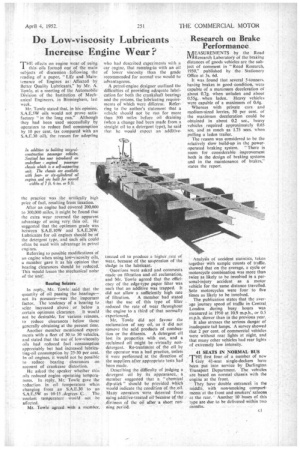Research on Brake Performance
Page 37

If you've noticed an error in this article please click here to report it so we can fix it.
lt/lEASUREMENTS by the Road al-Research Laboratory of the braking distances of goods vehicles are the subject of comment in "Road Research, 1950," published by the . Stationery Office at 3s. 6d.
It was found that several 5-tonners, having brakes in good condition, were capable of a maximum deceleration of about 0.7g. when unladen and about 0.55g. when laden. Heavy vehicles were capable of a maximum of 0.4g.
Whereas with private cars and medium-sized lorries, 50 per cent. of the maximum deceleration could be obtained in about 0.2 sec., heavy vehicles required approximately 0.65 sec. and as much as 1.75 secs. when pulling a laden trailer.
The reason was considered to be the relatively slow build-up in the poweroperated braking system. "There is room for considerable improvement both in the design of braking systems and in the maintenance of brakes," states the report.
Analyiis of accident statistics, taken together with sample counts of traffic, showed that on the average, a cycle or motorcycle combination was more than twice as likely to be involved in a personal-injury accident as a motor vehicle for the same distance travelled. Solo motorcycles were four to five times as likely to be involved.
The publication states that the average journey speed of traffic in Central, London during busy hours was measured in 1950 at 10.9 m.p.h., or 0.5 m.p.h. slower than in the previous year.
It also stresses the serious danger of inadequate tail lamps. A survey showed that 2 per cent. of commercial vehicles were without rear lights at night, and that many other vehicles had rear lights of extremely low intensity.
41 SEATS IN NORMAL BUS THE first four of a number of new 1 Guy 41-seat single-deckers have been put into service by Darlington Transport Department. The vehicles are based on normal chassis with the engine at the front.
They have double entrancei in the middle, with non-smoking compartments at the front and smokers' saloons at the rear. Another 10 buses of this type are due to be delivered within two months.
























































































